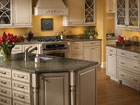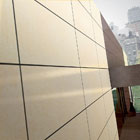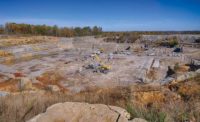
With the continual evolvement of green building in
recent years, stone and tile manufacturers are dedicating their efforts to
developing high-quality products that are also environmentally friendly. The
Wallpaper Collection by Trend USA offers tiles with up to 78% post-consumer
recycled glass.
When it comes to design and construction today, the subject of green building is certainly at the forefront. While architects and designers still work to create designs with intrigue and visual interest, they are also heavily considering a project’s sustainability and carbon footprint. More than ever, LEED (Leadership in Energy and Environmental Design) is part of the vocabulary when discussing plans for a new building design. And as a result, stone producers, tile manufacturers and those that manufacture stone and tile maintenance and installation products are now developing environmentally friendly products to meet these needs.
Developed by the U.S. Green Building Council (USGBC) in 1998, LEED is defined as “an internationally recognized green building certification system, providing third-party verification that a building or community was designed and built using strategies aimed at improving performance across all the metrics that matter most: energy savings, water efficiency, CO2 emissions reduction, improved indoor environmental quality and stewardship of resources and sensitivity to their impacts,” according to a statement on the USGBC’s Web site. The organization also explains that LEED is flexible enough to apply to all building types, including both commercial and residential designs.
And although LEED was first established more than a decade ago, it is only in recent years that it has stimulated such a buzz, causing a flurry of new products to hit the market. While many tile and engineered stone lines are promoting their recycled content, others are considered “green” due to their production process. In either case, the goal of the manufacturers remains the same: to entice architects and designers to choose their product lines when building with the environment in mind.

Ellen Blakeley Studio designs custom tile using
tempered broken glass that is recycled from commercial glass companies. Shown
is an example of the company’s True Blood series.
Being green does not mean that the aesthetic look of the product has to be compromised. In fact, glass tiles produced by Ellen Blakeley Studio originated because company owner and artist Ellen Blakeley was drawn to the idea of creating beautiful new tiles from recycled material.
“I used to have a ceramic tile business, and then in 1994, I was living in San Francisco and there was a lot of vandalism going on - teenagers were shooting at glass bus shelters with BB guns,” said Blakeley. “I was driving around saying to myself, ‘Look at all this gorgeous free material.’ I picked up about five to six pounds [of the glass] and started playing around with it.”
After taking some time to discover the possibilities, Blakeley realized that she was on to something. “At first, I didn’t come up with much, but a day or two later, I used clear glue on a multi-colored surface, and then that’s when the light bulb went on,” she said. “I realized that I was not limited to the color of the glass. I started making things immediately.”
Initially, Blakeley did not start making tile because the glass was too thick, she explained. “It was ¾ inches thick, so I started making vases, mirror frames, tabletops, etc.,” she said. “Later on, I switched to ¼-inch-thick glass, and I started to do tile.”

The most recent addition to Ellen Blakeley Studio’s
glass tile collection is Turquoise Lace.
For the first two years of her new venture, Blakeley collected glass off the streets of San Francisco to make her products. “I followed the vandalism around San Francisco,” she said. “I had a deal with my friends that whoever spotted a broken shelter I would make them something. Then I met a man in the commercial glass business in San Francisco, and since then, I’m hooked into two or three big glass companies. I get all their recycled glass.”
Blakeley explained that her studio basically works with the glass remnants left as a byproduct from commercial companies. “As far as I know, I was the first person who started using tempered glass as a broken art form,” she said. “More and more people are using broken glass now, so it [is getting harder to find.]”
When Blakeley first began making tabletops and mirror frames, she titled her line “Recycled Vandalism.” “I was pretty hip to the fact that I was recycling,” she said. “[At the time], I think people loved the fact that it was recycled, but that wasn’t hooking them in,” said Blakeley. “They were intrigued by the look. About two years ago, I got a flurry of inquiries from all my showrooms asking questions like: ‘How green is your product?’ ‘How much VOCs do you use?’ ‘How biodegradable is the grout?’ We had to do some research.”
According to Blakeley, overall her glass tiles rate very well. “Everything breaks down really well, except the epoxy, but I use very little per tile - maybe 2%,” she said, adding that she waits in anticipation for an environmentally friendly epoxy to become available. “I use every ounce of recycled glass that comes in, but if there is anything that I don’t use, I sell it to the Institute of Mosaic Art (IMA) [in Oakland, CA] for a very minimal fee. They then sell it to their students. I teach there three to five times a year.
“The way I look at it is that I got really lucky,” Blakeley went on to say. “I knew what I bumped into was very cool. I was smart enough to know that this was amazing. I was in the right place at the right time.”

Cosentino, a leading manufacturer of quartz surfacing
and a large importer of natural stone from around the world, recently launched
ECO™ by Cosentino, a revolutionary new line of countertop and surfacing
material composed of 75% recycled material.
While Blakeley might have been ahead of the curve in the use of recycling material to make new tile, many manufacturers are quickly catching up and introducing innovative new products. For example, Cosentino, a leading manufacturer of quartz surfacing and a large importer of natural stone from around the world, recently launched ECO by Cosentino, a revolutionary new line of countertop and surfacing material composed of 75% recycled material.
The result of a $6 million research and development investment, this innovative new product caters to the environmentally conscious and design-oriented architect, designer and consumer by providing high-performance, design and sustainability, according to the manufacturer.
ECO by Cosentino is composed of 75% post-industrial and post-consumer recycled raw material. By utilizing recycled materials, Cosentino is “upcycling” products that have reached the end of their lifecycle - meaning that they cannot be incorporated into any other industrial product and would otherwise collect in landfill sites. According to Cosentino, approximately 3,000 glass bottles equal 1 ton of raw materials. The production of ECO by Cosentino is expected to re-use the equivalent of more than 11 million glass bottles, 2 million standard size bathroom mirrors and approximately 540,000 square feet of ceramics every year, reports the company. The recycled content is then mixed with 25% natural material, including stone scrap from mountains, quarries, manufacturing and fabrication; and is bonded together with a proprietary eco-friendly 22% corn oil resin.
ECO by Cosentino is achieved through state-of-the-art technology and delivers a hard durable surface that has high stain, scratch and scorch performance, the manufacturer reports. “Unlike concrete-based countertops, ECO is a non-porous surfacing material and does not require sealers,” stated Cosentino. “ECO by Cosentino matches the sophisticated look, feel and high performance of quartz composite surfaces and natural stone surfaces such as marble and granite.”
The product is available in jumbo slabs of 63 x 128 inches and standard tile sizes of 12 x 12, 18 x 18 and 24 x 24 inches. “The jumbo slabs allow for a higher square footage of material per container, therefore minimizing the product’s carbon footprint, and they provide a higher yield of material during fabrication - minimizing seams and waste,” stated Cosentino.
Additionally, the company explained that architects and building teams will gain points toward LEED certification from the U.S. Green Building Council for a building project that utilizes ECO by Cosentino surfacing, as the product is Greenguard certified for low chemical emissions. I got really lucky,” Blakeley went on to say. “I knew what I bumped into was very cool. I was smart enough to know that this was amazing. I was in the right place at the right time.”

Vermont Quarries of Mendon, VT, recently achieved
Greenguard Indoor Air Quality and Greenguard Children & Schools SM
Certification for marble surfacing. Vermont Danby marble has met the
qualification standards for LEED certification credit 7.1: Heat Island Effect,
non-roof: Using light-colored natural stone with a solar-reflective index of 20
or greater can reduce heat-island effects. Danby marble comes in at over 60.
And while products consisting of a high content of recycled material have gained in popularity, they are not the only considerations when selecting environmentally friendly building products. Genuine stone can also earn a project LEED points and is the most natural representation of a “green” product.
Vermont Quarries of Mendon, VT, recently achieved Greenguard Indoor Air Quality and Greenguard Children & Schools SM Certification for marble surfacing. Greenguard-certified products must meet stringent emissions requirements set by the Greenguard Environmental Institute (GEI), such as being screened for more than 10,000 chemicals. Greenguard Certified products are recognized, referenced or preferred by many retailers, companies, institutions, government agencies, environmental programs, standards and specifications around the globe. All certified products can be found in a free online product guide at www.greenguard.org.
Vermont Quarries also reports being the first quarry to have its complete line of marble certified under this program. Vermont Danby marble has met the qualification standards for LEED certification credit 7.1: Heat Island Effect, non-roof: Using light-colored natural stone with a solar-reflective index of 20 or greater can reduce heat-island effects. Danby marble comes in at over 60, according to the company.
“We feel it is important to look for ways to move progressively forward in terms of making Danby marble a viable solution for residential use and commercial design,” said Todd Robertson, Director of Market Development for Vermont Quarries. “Greenguard gives us both aspects in terms of letting homeowners know that Danby marble is a clean, safe marble to have in their homes.” All Danby slabs will be labeled with the Greenguard certification stickers. This will let clients know that not only is Danby marble highly suitable for kitchens due to its low absorption, but also, it is a clean and safe marble to use in their home.
In regards to commercial projects, it is possible that the Greenguard certification will qualify Danby marble for another LEED certification point under innovation and design. “For commercial buildings, this certification provides yet another LEED point for using Danby which is very important to our philosophy of supporting the green movement and innovating what we can do with our marble,” said Robertson. “We are extremely excited to be the first and only marble quarry to have its entire production Greenguard certified.”
With LEED certifications so far, Danby marble will add to any project within 500 miles of the quarry two LEED points confirmed with a possible third with Greenguard. If the project is outside of the 500 mile radius, a minimum of one to two points will still apply.
Vermont Quarries also is taking measures to share its knowledge by offering its availability to give companies a CEU Learning AIA Credit with a presentation on “Marble Use in the Kitchen.” Everyone in attendance, including architects and designers, will receive one learning credit.

Custom Building Products’s complete line of
lightweight products conserves energy by using less fuel for transport, and
many of these products contain recycled materials.
In addition to developing products that are environmentally friendly, manufacturers are also diligently working to maintain an efficient manufacturing plant. Custom Building Products, a large manufacturer of stone and tile maintenance and installation products, has made its commitment to environmental responsibility well known.
“We search continuously for ways to reduce the burden on the environment and promote sustainability,” stated Custom Building Products. “Custom’s Build Green program is a leading model in the construction industry - supplying customers with environmentally-friendly products and the peace of mind that they are contributing to a cleaner world.”
The company reports that most of its products help contribute to LEED certification in at least one of three categories: low-emitting materials that contribute to indoor environmental quality, recycled content or local manufacturing and raw materials from within 500 miles of manufacturing site.
“Regional production of our products at 10 locations throughout the country ensures many products will be manufactured within 500 miles of a project site - reducing transportation emissions,” stated Custom Building Products. “[Also], Custom’s complete line of lightweight products conserves energy by using less fuel for transport, and many of these products contain recycled materials.”
The company also stresses that it adheres to tight, self-imposed requirements to minimize waste and pollution at every facility, and all plants follow stringent energy conservation guidelines. “Waste is reduced through source reduction and recycling, and disposed of by safe, environmentally responsible means,” stated Custom Building Products. “Solid airborne particles in Custom’s plants are recycled so that they don’t end up in landfills, and waste is never permitted to enter the waterways. Custom conducts regular environmental assessments at each facility, seeking ways to operate more cleanly and efficiently, and reviews environmental impact as an important part of corporate planning.”

Ceracasa, a Tile of Spain-branded manufacturer, has
developed Bionic Tile, an innovative ceramic product that removes harmful
nitrous oxide (NOx) pollution from the air through a process of photocatalysis,
with the help of sunlight and humidity.
And while many manufacturers of stone and tile products are illustrating their dedication to the environment, Ceracasa, a Tile of Spain-branded manufacturer, has taken it even a step further by developing an innovative ceramic product that removes harmful nitrous oxide (NOx) pollution from the air through a process of photocatalysis, with the help of sunlight and humidity. The product, known as Bionic Tile by Ceracasa, was created in collaboration with the Universidad Politécnica de Valencia in Spain and FMC-Foret.
Bionic Tile by Ceracasa is capable of deconstructing harmful pollution (NOx) into products harmless to humans in a permanent and effective way. Nitrous oxide is the air contaminant responsible for acid rain and a leading cause of climate change and pulmonary diseases. As a result of its enamel and different additives (responsible for the continuous decontaminant effect), Bionic Tile by Cercasa destroys NOx, making it not harmful to people but beneficial to the growth of plants.
Bionic Tile by Ceracasa has been developed with the collaboration of the Universidad Politécnica de Valencia-Chemical Technology Institute, in a project led by Professor Dr. Hermenegildo Garcia and his team of researchers. For the analysis of the ceramic samples, the ISO 22197-12007 standards have been used. Data has shown high decontamination levels per hour / per square meter.
Bionic Tile may be used as external ceramic cladding, and because of its positive affect on the environment, it is attracting interest in eco-efficient buildings worldwide, reports the manufacturer. Bionic Tile by Ceracasa was awarded the prestigious Alfa de Oro by the Spanish Society of Ceramics and Glass in February of 2009 at Cevisama, the international tile exhibition that is held annually in Valencia, Spain, and it has been supported by various architecture and sustainability forums.
With green building continuing to gain momentum, stone and tile manufacturers will continue to research and develop to produce innovative products such as Bionic Tile, which will inspire environmentally friendly designs.


